5 Types of Rubrics to Use in Your Art Classes

Most art teachers use rubrics to assess students’ work. Rubrics are a great way to make sure students understand the expectations of the assignment. Because all the criteria are clearly defined, they make grading 100 still life artworks much easier. I use the term “easier” loosely here; we all know grading 100 artworks is never easy!
Choosing what type of rubric to use in your classes is an important choice. There are several different types of rubrics, and each has its own strengths and weaknesses. Spoiler alert, if you want to see my favorite type of rubric, jump right down to number 5!

First, let’s talk about how rubrics can describe the criteria. There are two main ways rubrics can do this, either in general terms or in more specific terms.

1. The General Rubric
This type of rubric defines characteristics of a successful artwork. It is “general,” meaning it does not define specific criteria for each project. Instead, it might define characteristics such as “technique” or “craftsmanship” you are looking for in each completed project.
The strengths of this type of rubric are you can share it with students to communicate a broad understanding of what makes “quality” work. It can be used over and over for different tasks such as sketchbook assignments and projects. It can also be used to help students assess their own work. Because it is generic, students will attain an understanding of your broad expectations through its continued use.
The weakness of this type of rubric is that it is very broad. It does not clearly define the criteria for each project.
2. The Task-Specific Rubric
A task-specific rubric is, as the name suggests, much more specific. It clearly defines the criteria for each assignment.
What is great about this rubric is that it makes expectations for each assignment very clear. Students can use this rubric to assess their success very easily. It also makes grading easier for teachers, because of its specificity.
The weakness of this type of rubric is that you need to make a new one for each assignment. This can be time-consuming.
Luckily, no matter what type of rubric you choose, there are always ways you can expedite your grading process. If you’re interested in learning more, Tim Bogatz shares some super helpful tips in the PRO Learning Pack, Expediting Your Grading Process . You’ll learn how to develop a more streamlined plan for all types of assessment. You can find this PRO Pack and more on assessment practices in PRO Learning.
Next, let’s talk about the structure of the rubric. Here, too, you have a few different choices.

3. The Analytic Rubric
An analytic rubric breaks down each aspect of the task being assessed. It assesses each criterion separately. For example, say you are teaching a lesson on landscapes to your students. You may want each student’s work to show:
- Foreground, Middleground, and Background
- Atmospheric Perspective
- Overlapping and Size Variation
In an analytic rubric, you would assess each of these criteria separately.
The great thing about these rubrics is they connect your instruction to the assessment very clearly. Students can use them to assess their own work easily. They can also be used for formative assessment. They can show growth when used to assess students again at the end of a unit. You can download an example below.

Download Now
4. The Holistic Rubric
A holistic rubric is much simpler than an analytic rubric. Instead of breaking apart all the separate criteria, a holistic rubric assesses them all together.
So, if we use the above example of a still life, a holistic rubric would lump all of the criteria together (foreground, middleground, background, atmospheric perspective, overlapping, etc).
The advantage of a holistic rubric is that grading is much faster for the teacher. You only have to come up with a single score for each artwork you grade.
The limitation of this style of rubric is that it is not very useful to share with students. Because it does not break down the task into separate criteria, students would have a hard time using it to assess their work. In addition, it is difficult for students to see where they might improve if all the criteria are all clumped together in a single score. You can download a sample Holistic rubric below.
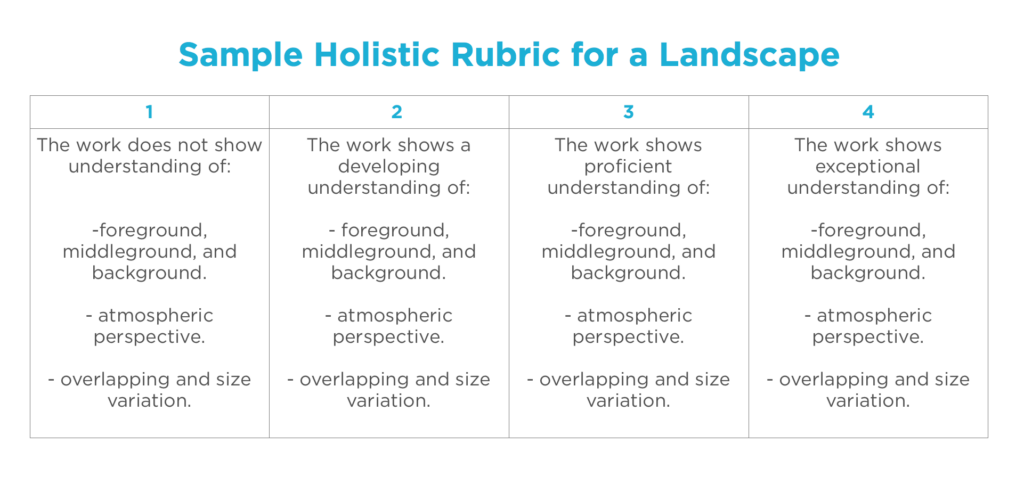
5. The Single-Point Rubric
In a single-point rubric, the expectations for the assignment are defined separately for a successful work, much like an analytic rubric. The difference is that criteria are only described for proficiency. Blank spaces are left for the teacher to write in feedback if the work falls above or below this point.
This is my favorite type of rubric. What I love about single-point rubrics is that they leave the teacher room to assess work individually. Instead of defining exactly what might make an artwork weaker or stronger, it leaves space for the teacher to give individual feedback for each student.
Yes, these take more work to fill out. I would not use a single-point rubric for every task. But for large projects, this is a great option. It gives the teacher the opportunity to give personalized feedback for each student. Once again, download an example below!

Rubrics are great tools to help communicate the expectations and assess students. If you choose the right rubric for the task, you will find it will help both you and your students be successful. For a comprehensive look at assessment in the art room, be sure to take a peek at the AOEU course Assessment in Art Education . You’ll leave class with a comprehensive toolkit of lesson plans and organization strategies.
What type of rubric do you use in your classes?
How do you give student feedback on your rubrics?
Magazine articles and podcasts are opinions of professional education contributors and do not necessarily represent the position of the Art of Education University (AOEU) or its academic offerings. Contributors use terms in the way they are most often talked about in the scope of their educational experiences.

Anne-Marie Slinkman
Anne-Marie Slinkman, an elementary school art educator, is a former AOEU Writer. She is passionate about providing relevant and meaningful art experiences for all students.
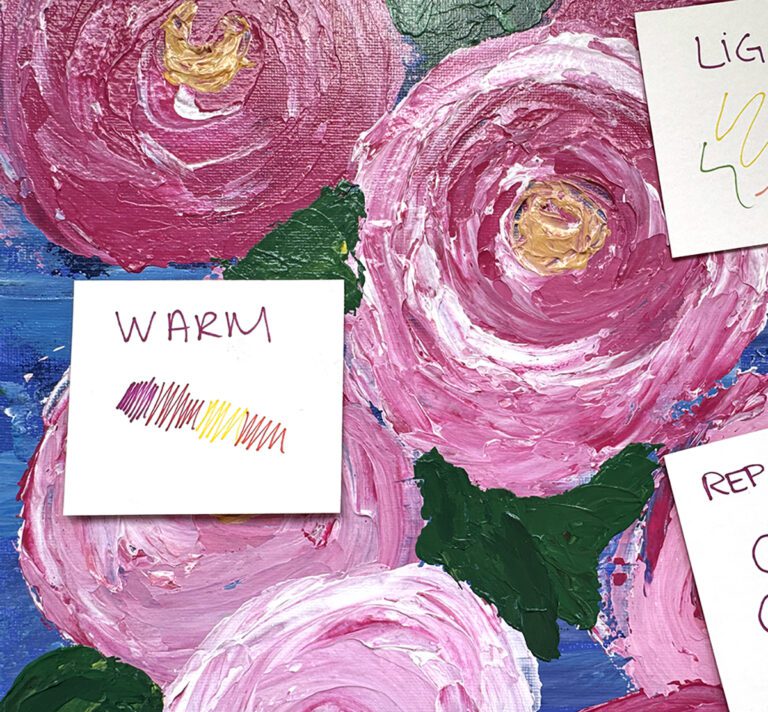
How to Support English Language Learners In Writing Powerful Artist Statements
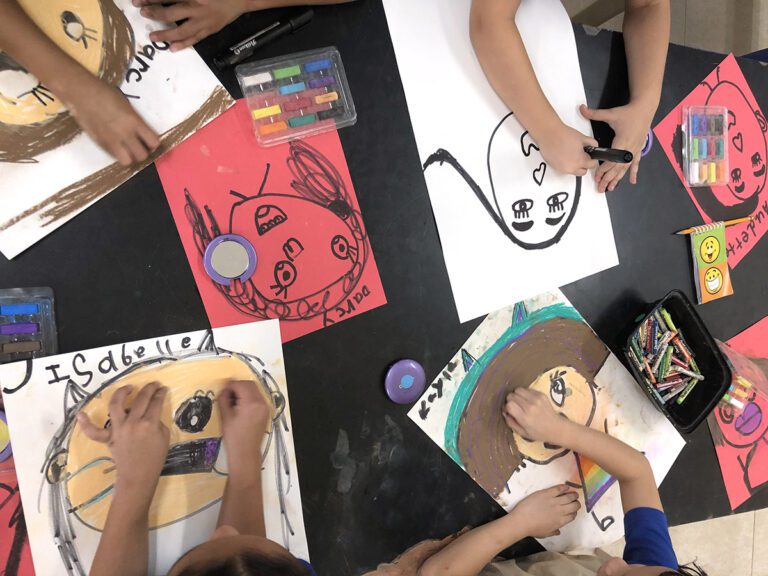
7 Ways to Process Artistic Growth With Your Elementary Students

10 Unique End-of-Year Portfolio Assessments for Secondary Art Students

How to Help Your Students Learn to Talk to Each Other Again
- Grades 6-12
- School Leaders
FREE Thanksgiving Worksheet Bundle for Last-Minute Activities 🦃
15 Helpful Scoring Rubric Examples for All Grades and Subjects
In the end, they actually make grading easier.

When it comes to student assessment and evaluation, there are a lot of methods to consider. In some cases, testing is the best way to assess a student’s knowledge, and the answers are either right or wrong. But often, assessing a student’s performance is much less clear-cut. In these situations, a scoring rubric is often the way to go, especially if you’re using standards-based grading . Here’s what you need to know about this useful tool, along with lots of rubric examples to get you started.
What is a scoring rubric?
In the United States, a rubric is a guide that lays out the performance expectations for an assignment. It helps students understand what’s required of them, and guides teachers through the evaluation process. (Note that in other countries, the term “rubric” may instead refer to the set of instructions at the beginning of an exam. To avoid confusion, some people use the term “scoring rubric” instead.)
A rubric generally has three parts:
- Performance criteria: These are the various aspects on which the assignment will be evaluated. They should align with the desired learning outcomes for the assignment.
- Rating scale: This could be a number system (often 1 to 4) or words like “exceeds expectations, meets expectations, below expectations,” etc.
- Indicators: These describe the qualities needed to earn a specific rating for each of the performance criteria. The level of detail may vary depending on the assignment and the purpose of the rubric itself.
Rubrics take more time to develop up front, but they help ensure more consistent assessment, especially when the skills being assessed are more subjective. A well-developed rubric can actually save teachers a lot of time when it comes to grading. What’s more, sharing your scoring rubric with students in advance often helps improve performance . This way, students have a clear picture of what’s expected of them and what they need to do to achieve a specific grade or performance rating.
Learn more about why and how to use a rubric here.
Types of Rubric
There are three basic rubric categories, each with its own purpose.
Holistic Rubric
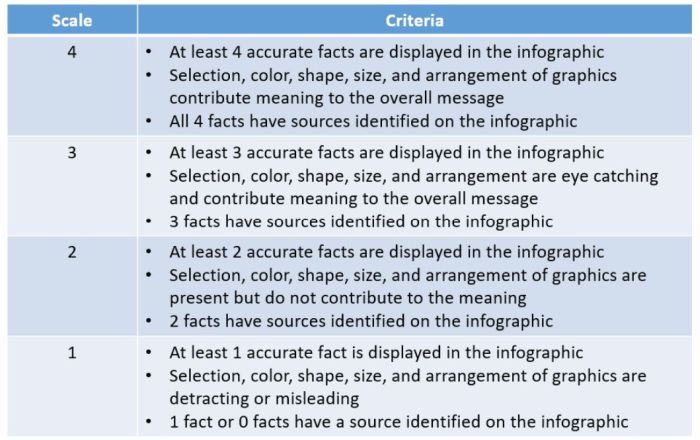
Source: Cambrian College
This type of rubric combines all the scoring criteria in a single scale. They’re quick to create and use, but they have drawbacks. If a student’s work spans different levels, it can be difficult to decide which score to assign. They also make it harder to provide feedback on specific aspects.
Traditional letter grades are a type of holistic rubric. So are the popular “hamburger rubric” and “ cupcake rubric ” examples. Learn more about holistic rubrics here.
Analytic Rubric

Source: University of Nebraska
Analytic rubrics are much more complex and generally take a great deal more time up front to design. They include specific details of the expected learning outcomes, and descriptions of what criteria are required to meet various performance ratings in each. Each rating is assigned a point value, and the total number of points earned determines the overall grade for the assignment.
Though they’re more time-intensive to create, analytic rubrics actually save time while grading. Teachers can simply circle or highlight any relevant phrases in each rating, and add a comment or two if needed. They also help ensure consistency in grading, and make it much easier for students to understand what’s expected of them.
Learn more about analytic rubrics here.
Developmental Rubric
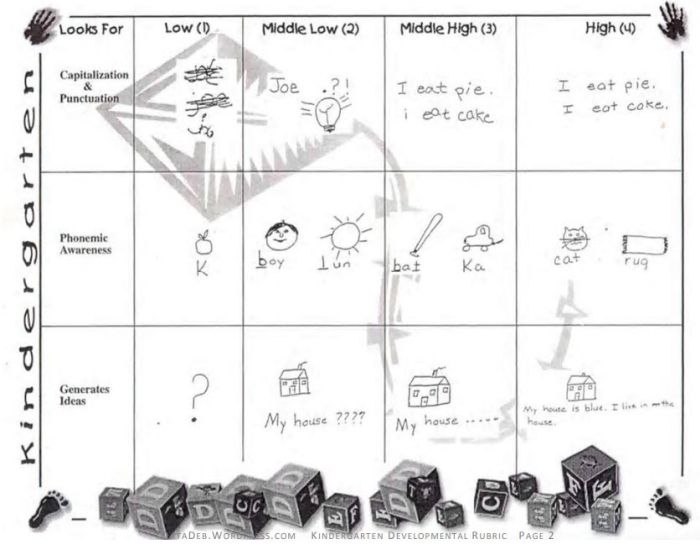
Source: Deb’s Data Digest
A developmental rubric is a type of analytic rubric, but it’s used to assess progress along the way rather than determining a final score on an assignment. The details in these rubrics help students understand their achievements, as well as highlight the specific skills they still need to improve.
Developmental rubrics are essentially a subset of analytic rubrics. They leave off the point values, though, and focus instead on giving feedback using the criteria and indicators of performance.
Learn how to use developmental rubrics here.
Ready to create your own rubrics? Find general tips on designing rubrics here. Then, check out these examples across all grades and subjects to inspire you.
Elementary School Rubric Examples
These elementary school rubric examples come from real teachers who use them with their students. Adapt them to fit your needs and grade level.
Reading Fluency Rubric

You can use this one as an analytic rubric by counting up points to earn a final score, or just to provide developmental feedback. There’s a second rubric page available specifically to assess prosody (reading with expression).
Learn more: Teacher Thrive
Reading Comprehension Rubric
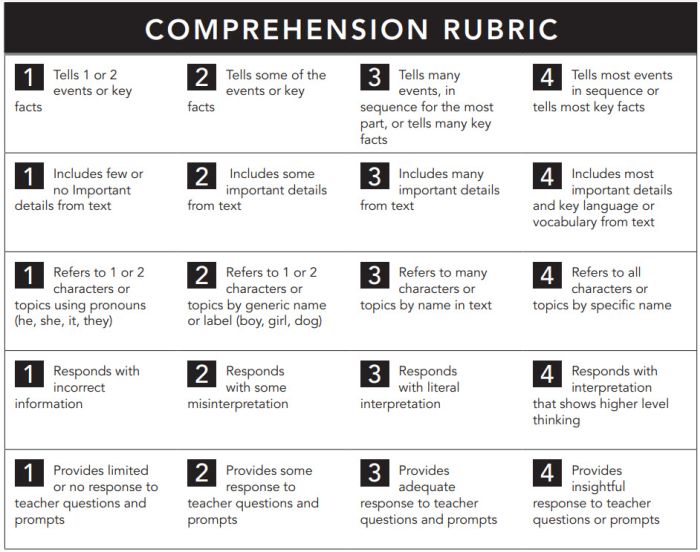
The nice thing about this rubric is that you can use it at any grade level, for any text. If you like this style, you can get a reading fluency rubric here too.
Learn more: Pawprints Resource Center
Written Response Rubric

Rubrics aren’t just for huge projects. They can also help kids work on very specific skills, like this one for improving written responses on assessments.
Learn more: Dianna Radcliffe: Teaching Upper Elementary and More
Interactive Notebook Rubric
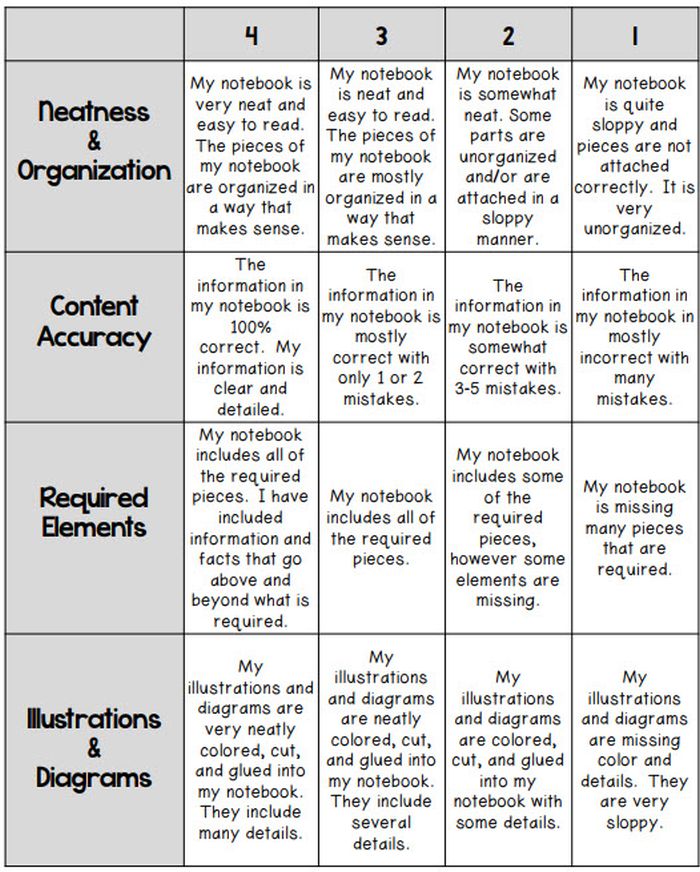
If you use interactive notebooks as a learning tool , this rubric can help kids stay on track and meet your expectations.
Learn more: Classroom Nook
Project Rubric

Use this simple rubric as it is, or tweak it to include more specific indicators for the project you have in mind.
Learn more: Tales of a Title One Teacher
Behavior Rubric
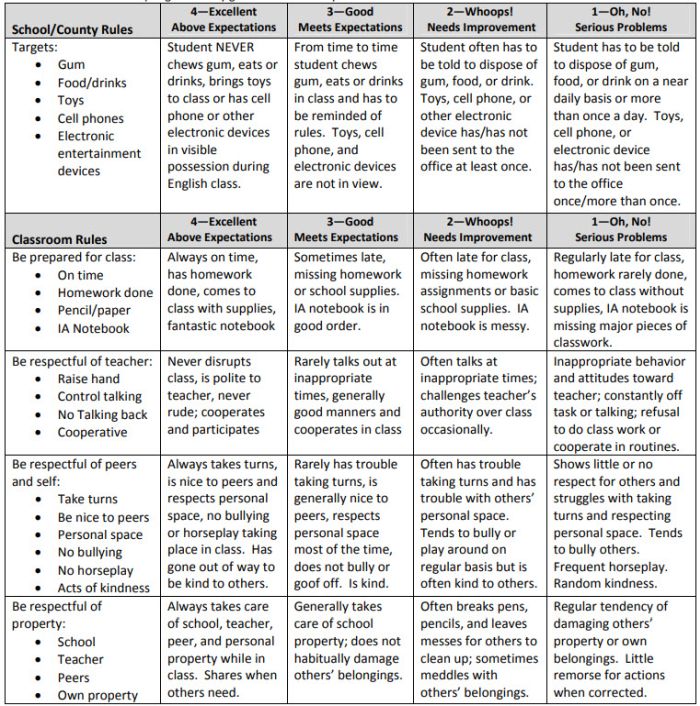
Developmental rubrics are perfect for assessing behavior and helping students identify opportunities for improvement. Send these home regularly to keep parents in the loop.
Learn more: Teachers.net Gazette
Middle School Rubric Examples
In middle school, use rubrics to offer detailed feedback on projects, presentations, and more. Be sure to share them with students in advance, and encourage them to use them as they work so they’ll know if they’re meeting expectations.
Argumentative Writing Rubric
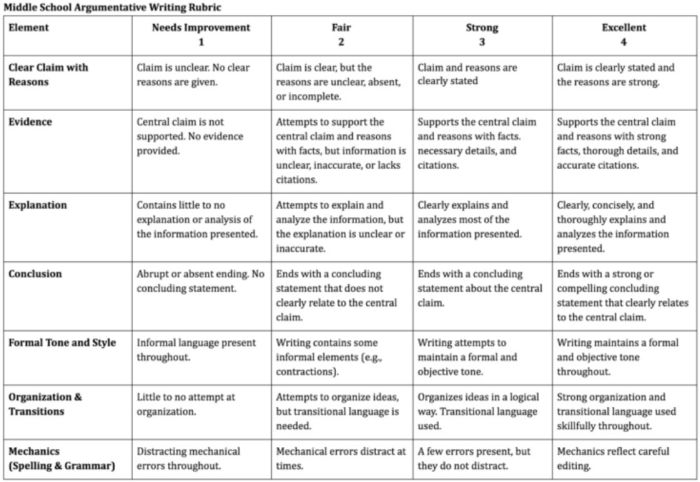
Argumentative writing is a part of language arts, social studies, science, and more. That makes this rubric especially useful.
Learn more: Dr. Caitlyn Tucker
Role-Play Rubric
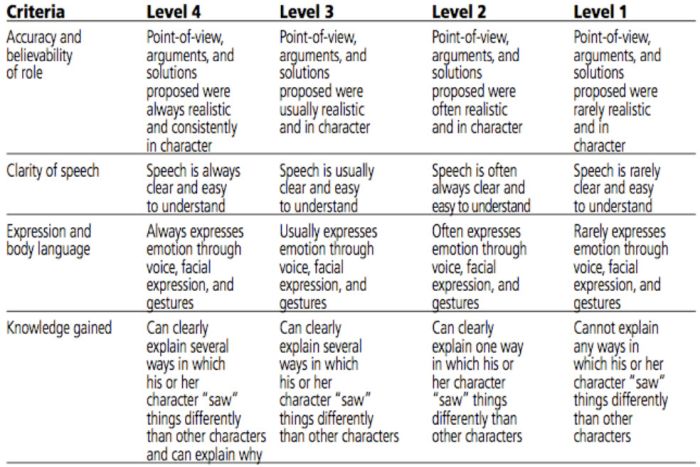
Role-plays can be really useful when teaching social and critical thinking skills, but it’s hard to assess them. Try a rubric like this one to evaluate and provide useful feedback.
Learn more: A Question of Influence
Art Project Rubric
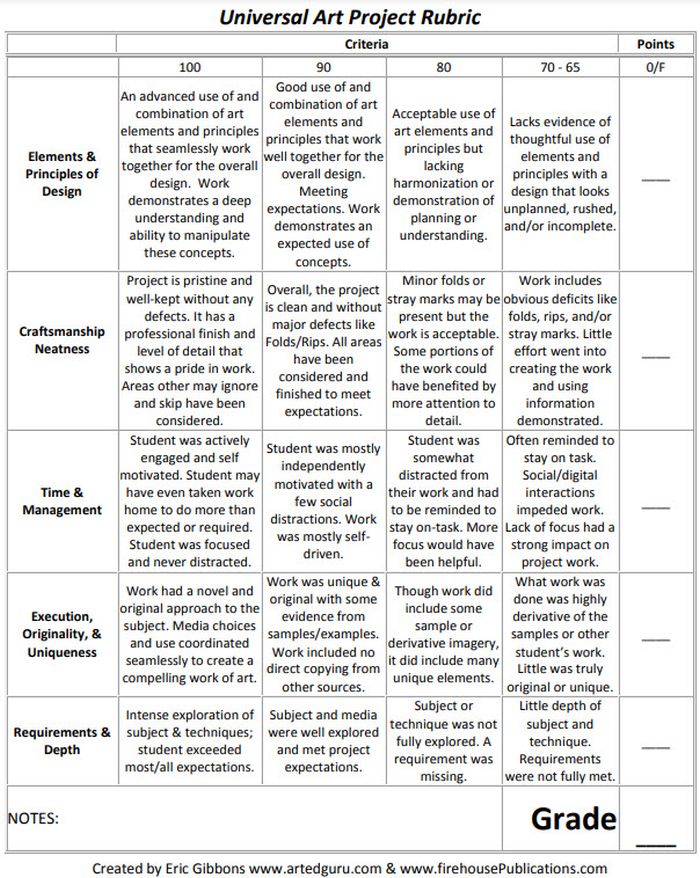
Art is one of those subjects where grading can feel very subjective. Bring some objectivity to the process with a rubric like this.
Source: Art Ed Guru
Diorama Project Rubric

You can use diorama projects in almost any subject, and they’re a great chance to encourage creativity. Simplify the grading process and help kids know how to make their projects shine with this scoring rubric.
Learn more: Historyourstory.com
Oral Presentation Rubric
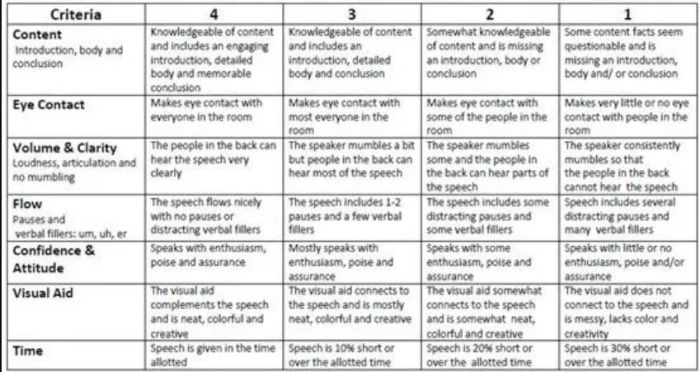
Rubrics are terrific for grading presentations, since you can include a variety of skills and other criteria. Consider letting students use a rubric like this to offer peer feedback too.
Learn more: Bright Hub Education
High School Rubric Examples
In high school, it’s important to include your grading rubrics when you give assignments like presentations, research projects, or essays. Kids who go on to college will definitely encounter rubrics, so helping them become familiar with them now will help in the future.
Presentation Rubric

Analyze a student’s presentation both for content and communication skills with a rubric like this one. If needed, create a separate one for content knowledge with even more criteria and indicators.
Learn more: Michael A. Pena Jr.
Debate Rubric
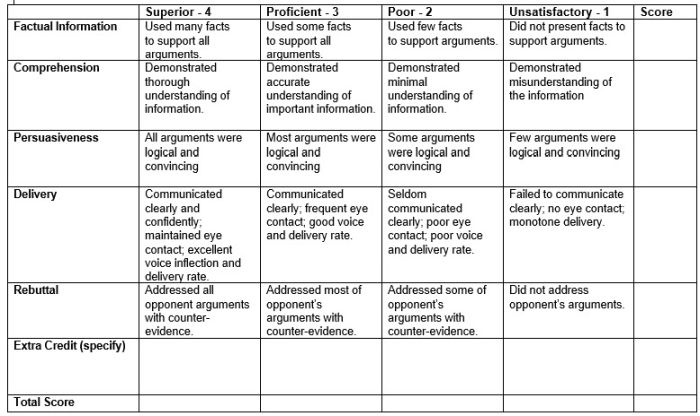
Debate is a valuable learning tool that encourages critical thinking and oral communication skills. This rubric can help you assess those skills objectively.
Learn more: Education World
Project-Based Learning Rubric
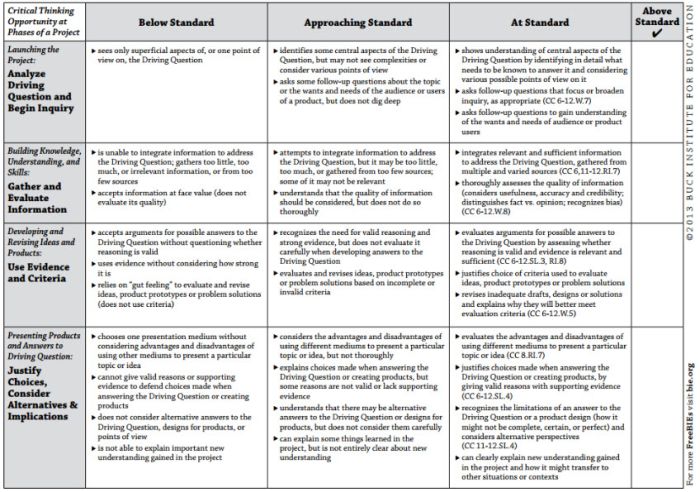
Implementing project-based learning can be time-intensive, but the payoffs are worth it. Try this rubric to make student expectations clear and end-of-project assessment easier.
Learn more: Free Technology for Teachers
100-Point Essay Rubric
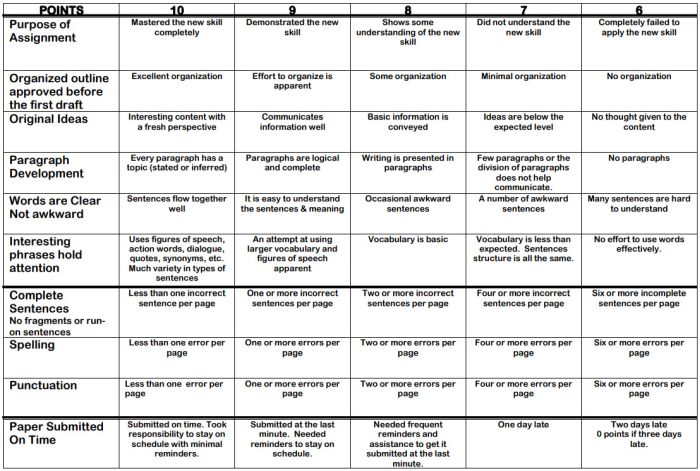
Need an easy way to convert a scoring rubric to a letter grade? This example for essay writing earns students a final score out of 100 points.
Learn more: Learn for Your Life
Drama Performance Rubric
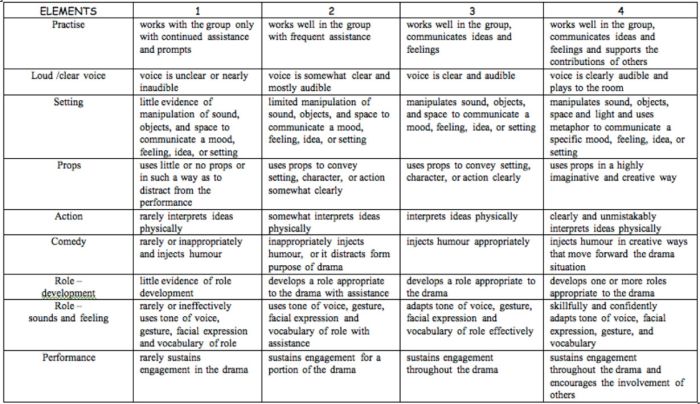
If you’re unsure how to grade a student’s participation and performance in drama class, consider this example. It offers lots of objective criteria and indicators to evaluate.
Learn more: Chase March
How do you use rubrics in your classroom? Come share your thoughts and exchange ideas in the WeAreTeachers HELPLINE group on Facebook .
Plus, 25 of the best alternative assessment ideas ..

You Might Also Like

Sweet! We’re Loving This Easy, Flexible Cupcake Rubric for Assessing All Kinds of Subjects
A sweet option for standards-based grading. Continue Reading
Copyright © 2024. All rights reserved. 5335 Gate Parkway, Jacksonville, FL 32256

Art Education Resources, Tips and Tricks and Art Lesson Ideas

Art Rubrics: How to Create Simple Grading Criteria
Before I started using art rubrics, I used to feel overwhelmed when it came time to grade students’ artwork. Since then I have created a rubric for every lesson I teach and it brings comfort to both myself and my students. Here is why I think rubrics are important, how to use them and how to create a rubric.
Benefits of Rubrics
Rubrics are great for providing feedback to students in a timely manner. If I do not see evidence of the student meeting the criteria, the student loses points in that specific category. I also provide a specific comment for the areas that need improvement. I also believe rubrics reduce subjectivity, which is important with art as it can be very subjective. Therefore, using the rubric increases objectivity and reduces my time grading time. I use the same four criteria on all my rubrics, which demystifies the learning goals and expectations. I reuse rubrics semester after semester, which also helps save time in the long run.

How to Use Art Rubrics
I provide my students with the rubric of expectations at the beginning of each lesson. Like I said, the categories stay the same for each lesson, but the lesson objectives change. I include the rubric in each of my PowerPoints and project the rubric during class to provide the students with the visual reference of the rubric. I return the completed rubrics to the students after each lesson. This allows them to reflect on how they can make improvements to future artwork.

Rubric Criteria
I use the following criteria for my rubrics.
Understanding Knowledge
This most often relates to the art history or content students are learning during the lesson. For example, students are creating a landscape inspired by Alma Thomas. Then students are provided with information about Alma Thomas, her painting style and the terms associated with landscapes. The assessment can be summative or formative based on the artwork created.
Developing Skills
This is the art technique taught during the lesson. Students demonstrate an understanding of creating depth in a landscape painting using size, color, texture, etc. It may also include creating a painting in a similar style as the featured artist Alma Thomas.
I think this is the most important criteria. I always propose every lesson as a creative problem the students are solving and encourage them not to copy my example or student examples, instead be inspired by what they see.
Craftsmanship and Effort
It doesn’t take long before I know each and every student’s personal best. They are told this at the beginning of the year. Students are encouraged to use the entire time given to create art that exceeds expectations. If the artwork looks like it is not meeting their personal best or if they did not use all class time available for this lesson, their effort grade will reflect these choices.
Craftsmanship is the neatness and care students put into finishing their work of art. For example, my students know that means erasing unnecessary pencil lines, cutting to create clean edges or painting in one direction to eliminate unwanted brushstrokes. I always provide examples of how students can be mindful of their craftsmanship with each medium we use.
How to Create Art Rubrics
There are many rubric generator websites available and I have tried several. Many times I feel the rubric generators are not easy to use or not applicable to art. However, I found the easiest way to create my own rubric is to use a word processing program that allows me to create a table and insert rows and columns for my criteria and grading equivalents. I create 6 columns, then I use Excellent, Substantial, Adequate, Limited (and assigned point value for each) for my four measures of skills achieved and the last column is the Total. Next, the 6 rows are labeled Criteria and the previously described Knowing & Understanding , Developing Skills, Thinking Creatively, Effort & Craftsmanship and the Total . Using the coordinating measure of skill and criteria I change the description to apply. Lastly, I title each rubric so I can keep it organized and with each lesson. I print the rubric and place them at the tables for the duration of the lesson or have students use the rubric for self-assessment of the lesson. In addition, I take a screenshot to create a JPEG to insert into my lesson PowerPoints.
Art is very subjective, which can make grading a daunting task. However, now that I have created rubrics for every lesson, grading is less time consuming and provides me with more time for lesson prep. All of my TPT lessons include a printable rubric as well as a rubric included in the PowerPoint presentation.
Happy grading! – Trista
If you liked this Art Rubrics post, please subscribe by clicking here.
Check out my How To Page for more posts like this.
- Share This Post

I’ve been teaching art for over 20 years and I love it!
I have taught every grade from kindergarten to high school. This site features art education articles with art resources and ideas as well as art lesson ideas for all ages. My goal is to allow students to explore a variety of art materials, discover different genres and styles, and most importantly, have FUN!
Product Spotlight

Free Art Resources
Follow artwithtrista on instagram.

CONTACT ART WITH TRISTA
Send me a message.
Please let me know any questions or comments you have. I’d love to hear them but I am a full time art teacher so I may not be able to get back to you as quickly as I would like.
Share this post
iRubric: Rubric for All Creative Art Assignments
- Arts and Design
- Skip to primary navigation
- Skip to main content
- Skip to primary sidebar
- Skip to footer
Don't Miss a Post! Subscribe

- Educational AI
- Edtech Tools
- Edtech Apps
- Teacher Resources
- Special Education
- Edtech for Kids
- Buying Guides for Teachers

Educators Technology
Innovative EdTech for teachers, educators, parents, and students
Art Rubric for Teachers
By Med Kharbach, PhD | Last Update: May 16, 2024

As an educator with a passion for fostering creativity and artistic expression in the classroom, I’ve always believed in the transformative power of art. Art isn’t just about producing a visually pleasing work; it’s a journey of self-expression, exploration, and critical thinking.
However, assessing art can be quite challenging due to its subjective nature. To bridge this gap, I am sharing with you this handy rubric that aims to fairly evaluate students’ art projects. This rubric is designed to respect the individuality of each student’s artistic expression while providing a structured way to assess their work on several key components. It’s important to remember that while we strive for objectivity in assessment, the heart of art education lies in encouraging students to express themselves and explore their talents.
Related: 15 Fall Art Projects and Activities for Kids
Art Project Rubric
This rubric balances the subjective aspects of art with more objective criteria, like effort and technique. It’s adaptable to various art projects and grade levels. Remember, the ultimate goal is to encourage students to explore their creativity while developing their skills and understanding of art principles.
1. Creativity and Originality
- Exceptional: The artwork displays a high level of creativity and originality. The student demonstrates unique approaches and imaginative ideas.
- Good: Shows creativity but may rely on some common ideas or techniques.
- Fair: Limited creativity, largely uses conventional approaches.
- Needs Improvement: Little to no creativity or originality in the work.
2. Use of Media and Techniques
- Exceptional: Outstanding use of the medium and techniques; demonstrates mastery.
- Good: Good use of medium, with minor errors or inconsistencies.
- Fair: Adequate use of medium but with noticeable errors or lack of skill.
- Needs Improvement: Poor use of medium, significant errors in technique.
3. Composition and Design
- Exceptional: The composition is exceptionally well planned. Elements of design are expertly used.
- Good: Well-composed, but may lack some complexity or depth.
- Fair: Basic composition, lacks balance or sophistication.
- Needs Improvement: Poor composition, elements of design are not effectively utilized.
4. Effort and Perseverance
- Exceptional: Demonstrates outstanding effort and commitment. Goes beyond the assignment requirements.
- Good: Good effort and time spent, meets the assignment requirements.
- Fair: Adequate effort; does the minimum required.
- Needs Improvement: Little effort or engagement with the assignment.
5. Reflection and Artistic Insight
- Exceptional: Provides deep, thoughtful reflection on their work and process. Shows high level of artistic insight.
- Good: Some reflection and insight, but may not be fully developed.
- Fair: Basic reflection, lacks depth or detail.
- Needs Improvement: Little to no reflection or insight into the artistic process.
Final thoughts
Using this artnrubric, we can offer students clear and constructive feedback, guiding them to refine their skills and encouraging deeper engagement with their artistic processes. It’s crucial, though, to remember that a rubric is merely a tool. The true essence of art education lies in the conversations we have with students about their work, the encouragement we offer, and the environment we create that values creativity and personal expression.

Join our mailing list
Never miss an EdTech beat! Subscribe now for exclusive insights and resources .
Meet Med Kharbach, PhD
Dr. Med Kharbach is an influential voice in the global educational technology landscape, with an extensive background in educational studies and a decade-long experience as a K-12 teacher. Holding a Ph.D. from Mount Saint Vincent University in Halifax, Canada, he brings a unique perspective to the educational world by integrating his profound academic knowledge with his hands-on teaching experience. Dr. Kharbach's academic pursuits encompass curriculum studies, discourse analysis, language learning/teaching, language and identity, emerging literacies, educational technology, and research methodologies. His work has been presented at numerous national and international conferences and published in various esteemed academic journals.

Join our email list for exclusive EdTech content.
- Skip to main content
- Skip to primary sidebar
- Search this site...
- 0 item(s) $ 0.00
Glitter Meets Glue
Sparkling Art Teacher Resources
5 Art Rubric Grading Tips for Student Artwork Assessment
Amie Bentley Art Assessment , Blog Leave a Comment
As an art teacher, you’ve designed the perfect project , but now you’re stuck figuring out how to create an art rubric for grading your students’ artwork. You’re unsure of which criteria to include or how many performance levels to target. Don’t worry—I’ll walk you through it all step by step. By the end, you’ll be creating your own grading rubrics for elementary and middle school art projects with ease!

Shop This Post!
Editable art rubric for elementary & middle school.

What is an Art Grading Rubric?
An art rubric is a scoring tool that defines specific criteria for evaluating a student’s artwork. Rubrics outline what you expect in areas like craftsmanship, art concepts, creativity, and completion of the project’s objectives. Unlike exit tickets , which serve as formative assessments, rubrics are used at the completion of a project.
Why Use Art Rubrics in Elementary and Middle School?
Grading artwork can be challenging due to their subjectivity, making it hard to assign fair scores that reflect students’ effort, creativity, and craftsmanship. Without a clear evaluation system, students and their parents may express distrust.
Art rubrics not only clarify expectations but also make grading artwork faster and more efficient. In large classes, grading can become overwhelming. Without clear rubrics, students or parents might question fairness, leading to frustration.
In my teaching career, I’ve managed anywhere from 80 to 950 students a year. If you spend just one minute per project, grading 600 students would take a staggering 10 hours!
A well-designed rubric simplifies grading.

Lastly, art rubrics aren’t just for teachers! Have students use them to evaluate their own or a peer’s work. Using a self-assessment rubric for art projects builds critical thinking skills and encourages them to view their art more objectively.
How Can You Create Your Own Art Rubric?
Are you ready to create your first rubric? First, to design an effective grading rubric template for an art project, you’ll need to focus on 2 essential elements:
- Criteria (what you’re assessing)
- Performance Levels (the degree to which the criteria is met)
Let’s look at both.

Core Criteria for Grading Artwork
After reviewing numerous visual art rubrics for both elementary and middle school, here’s a list of all the most common criteria. And some thoughts on how myself, and other art teachers, use them in assessments:
Art Concepts
Craftsmanship, completeness, focus, time management, or work habits, following directions and expectations, project goals.

This criterion refers to the elements of art and principles of design. Your rubric may target a specific element or principle, or address them in general. For instance, if your lesson focuses on analogous colors, you’ll want to assess whether students effectively incorporated these colors into their projects.
This one’s pretty self-explanatory. For art teachers using the Studio Habits of Mind framework, assessing cleanup can be particularly significant. That’s because taking care of tools and materials is a function of being an artist, which is what the Studio Habits strive to teach.
In my art room, I emphasize teamwork with the motto, “If you make the mess, you help clean it up.” Consider whether students participated in cleaning up their workspace and offered assistance to their peers.
Craftsmanship refers to the neatness and skill demonstrated in using art materials, often described as media skills. You may be assessing either direct or indirect media skill acquisition.
In painting lessons, craftsmanship might involve how students control their brushstrokes, while in drawing, it could focus on shading techniques.

It’s also essential to consider students’ Individualized Education Programs (IEPs) and how they might impact grading. Be aware of which students have IEPs and the physical challenges they may face that could affect their craftsmanship skills. Adjust your expectations accordingly to ensure a fair and equitable assessment.
Every art lesson presents a problem to solve, and each student should approach that problem in their own unique way.
I typically avoid showing numerous example projects—sometimes opting not to show any at all—because students often perceive these as “the right answer” and may resort to copying. Some may also copy their peers, making originality harder to trace.
Instead, we focus on discussing how to take inspiration from existing ideas and combine or refine them to create something original. This process of exploration and personal expression is what I assess in their work.
Ideally, projects should be finished to their logical conclusion. However, there are instances when they may inadvertently extend into another marking period outside of your control. In such cases, I assess the project based on the amount of work completed relative to the expectations for that marking period.
All 3 of these are closely related concepts in the art classroom. If you’re using the Studio Habits of Mind, you can target the habit called, “Engage and Persist” in your lessons.
Regardless, all of these concepts basically refer to “time on task.” It’s essential to assess if your students dedicated their entire class period to their project. Or did they spend all period in off-topic conversations?

It’s important to clarify that time management is not assessing a student’s behavior . The goal is to evaluate whether students are actively working on and discussing their projects. Any specific, off-task comments should not factor into this assessment (see Tip #2 for more on this).
This criterion assesses a student’s ability to observe, listen, read, and execute demonstrated instructions.

Some students may excel at grasping the steps conceptually but struggle to apply them due to limited creativity or media skills. I firmly believe that assessing how well my students can follow directions, I’m able to better credit their learning process (i.e. they understand the steps to making a reductive print), even if their final project isn’t aesthetically pleasing.
Project goals are the learning objectives or skills students are expected to achieve by the end of an assignment. These objectives align with your lesson plan and may emphasize artistic techniques, conceptual understanding, or personal expression.
Project goals can also involve smaller, supporting tasks—like sketchbook drawings, brainstorming exercises, or worksheets—that help students develop their ideas and meet the overall assignment requirements.
Some art projects involve materials or tools that require careful handling, such as special inks, dyes, or sharp tools. In these cases, it’s helpful to assess students’ adherence to safety guidelines as part of the art rubric.
For example, when working with plaster in 4th and 5th grade, I emphasize the rule, “Don’t blow the dust.” Plaster dust is harmful if inhaled, especially for students with respiratory conditions. By assessing safety, you promote responsible behavior, ensuring a safer environment for all students.
Art Rubric Performance Levels
Decide whether you want to assign points (e.g., 1-4), use descriptive levels (e.g., “Exceeds Expectations” vs. “Needs Improvement”), or a combination of both.

As far as how to label them, some examples might include:
- Exceeds… / Meets… / Approaches… / Missed Expectations
- Advanced / Proficient / Basic / In-Progress
- Extraordinary / Above Average / Average / Below Average / Poor
- Excellent / Good / Fair / Poor
- Outstanding / Satisfactory / Needs Improvement / Unsatisfactory
- Mastery / Developing / Emerging / Beginning
- Expert / Apprentice / Novice
Of course, if you want to appeal to the Gen Z and Gen A crowd with playful language, you could go with:
- Fire / Drip / Mid / Cringe
- Lit / Vibe / Chill / Sus

For the youngest learners, these might be engaging:
- Rockstar / Solid / Getting There / Not Yet
- Gold / Silver / Bronze / Try Again
- Wow! / Nice Work / Keep Going / Needs More
I would stick with 3 levels for lower elementary, and 4 – 5 levels for 3rd grade and up. Any of the ideas above can be reduced to just 3 performance levels.
Now that you have an idea of what’s included on an art rubric, here are some additional thoughts on creating them.
1. Keep It Simple for Lower Elementary
- For young learners, minimize the text. Use straightforward criteria labels like craftsmanship , creativity , and clean-up , but skip lengthy definitions or criteria descriptions.
- Limit your rubric to 3-4 criteria with a matching number of performance indicators.
- For upper elementary and middle school, you can include more text. But keep the language simple and concise.

Today’s students (and let’s be honest, most of us) are content scanners. When you landed on this page, did you quickly scan for the key parts?
Students do the same. More text doesn’t equate to better understanding, especially if it includes unfamiliar terminology that hasn’t been explicitly taught. Aim for short, clear, and easily interpretable content.
2. Kick Behavior Criteria to the Curb
Including behavior on an art evaluation rubric is an outdated practice. Behavior should not affect an art grade because it:
- Unfairly penalizes them for non-academic issues
- Doesn’t reflect what they’ve learned or the skills they’ve developed
Even more concerning, students with ADHD, autism, anxiety, or other challenges may struggle with behaviors that have nothing to do with their artistic abilities. Penalizing them for these behaviors creates unnecessary barriers and fails to promote a fair learning environment.
3. Leave Room for Comments
Whenever possible, include space on your rubric for written comments. Constructive feedback is essential for student growth and helps students understand what they can focus on improving in future projects.

For self-assessment rubrics, it’s equally important to provide space for students to reflect on their work. This allows them to share additional thoughts, insights, or context that might not be captured by the rubric alone.
I use a question such as, “Is there anything else you would like to explain about your art?”
4. Use Engaging Visuals
It’s art class, after all—so why not incorporate clear, engaging visuals into your grading rubrics?
- For younger grades, consider using emojis exclusively to represent performance levels. Emojis provide a quick, intuitive way for students to understand abstract concepts. Young children, emerging readers, or students with language challenges (like English language learners) can struggle with text-heavy rubrics. Emojis bridge that gap by making expectations easy to grasp and accessible for everyone.
- For all grade levels, include icons to represent each criterion on the rubric. Just like emojis, icons help convey meaning at a glance and reduce cognitive load, allowing students to focus on their work instead of decoding complex language.

Bonus tip: Use the same icons throughout your art room—on posters, handouts, and homework assignments—to create consistency and reinforce expectations. Familiar visuals help students feel more comfortable and confident navigating different tasks.
5. Set Clear Expectations from the Start
At the beginning of the lesson, review the rubric with your students. This ensures they understand what’s expected before they even start the project.
For challenging middle school classes, I have students bring the rubric home to get it signed and returned for a homework grade. This not only reinforces accountability but also encourages parent communication. If your evaluation includes parent engagement, this strategy can count toward meeting that goal, too!
Ready to Save Time on Creating Art Rubrics?
If you’d like to save time creating rubrics from scratch, my Editable Art Rubric Template is a great place to start! It’s customizable to fit any art project and makes grading artwork a breeze.

Final Thoughts
Grading artwork doesn’t have to be complicated or subjective. A clear and simple art rubric helps you assess projects fairly, communicate expectations, and make evaluating art projects more efficient. Whether you use my editable template or design your own, these tips will ensure your students feel supported and understood.
Have any questions on anything I didn’t cover? Drop a comment below and I’ll reply.

About the Author
Amie bentley.
I'm a 20-year veteran art teacher with kindergarten - 8th grade teaching experience. I spent my first 4 of 20 years co-teaching in general ed classrooms. As a highly-qualified visual arts teacher in the State of New Jersey, I was honored to be Teacher of the Year my 3rd year of teaching. In addition to teaching, I also have graphic design experience.
You may also enjoy these posts...

Reader Interactions
Leave a comment cancel reply.
Your email address will not be published. Required fields are marked *
This site uses Akismet to reduce spam. Learn how your comment data is processed .
Check it Out!
Step-by-Step Video Tutorials on YouTube
On my channel, I share inspiration for teachers to use arts integration in their classroom and homeschool curriculum. And I get kids excited about drawing, painting, and other forms of art.

Let’s chat!
Join the discussion in our Facebook community
Have a burning question about how to teach art that needs asking? Harness the power of community in my Elementary Art Teachers (K-8) Facebook group! Come share, collaborate, and learn new tips and tricks of the trade.
Helpful Links

IMAGES
VIDEO
COMMENTS
A rubric that properly evaluates the artistic process. It measures the various phases and approaches that are necessary in the assessment of a project or a work of art. Rubric Code: T9382A
Most art teachers use rubrics to assess students’ work. Rubrics are a great way to make sure students understand the expectations of the assignment. Because all the criteria are clearly defined, they make grading 100 still life artworks much easier.
Scoring rubrics help establish expectations and ensure assessment consistency. Use these rubric examples to help you design your own.
A rubric that properly evaluates the artistic process. It measures the various phases and approaches that are necessary in the assessment of a project or a work of art.
Many times I feel the rubric generators are not easy to use or not applicable to art. However, I found the easiest way to create my own rubric is to use a word processing program that allows me to create a table and insert rows and columns for my criteria and grading equivalents.
Art projects without a specific rubric or other assessment criteria will be evaluated and graded using the following rubric. Demonstrartion that instructions and concepts are understood. The artwork is planned carefully; understanding of all concepts and instructions is clearly shown.
Grading Portions: When I want to grade a portion of a project or the use of an element or principle for a sketchbook assignment, I have found the following 2 rubrics helpful. You can use the whole rubric to grade, like for an elements benchmark.
To bridge this gap, I am sharing with you this handy rubric that aims to fairly evaluate students’ art projects. This rubric is designed to respect the individuality of each student’s artistic expression while providing a structured way to assess their work on several key components.
Discover 5 effective tips for creating an art rubric that enhances assessment, engages students, & streamlines grading artwork for teachers!
RUBRIC: FIGURE DRAWING 4 3 2 1 Composition Large, centralized, well-balanced composition, with Minimal empty space Centralized and balanced composition, with some empty space Figure too small or too big, unbalanced composition with some empty space Figure too small or too big, off-center composition, with excessive empty space Wide range of